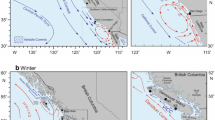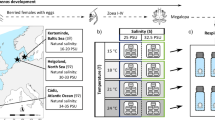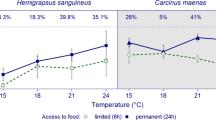Abstract
Introduced populations can cause ecological and economic damage and are difficult to eradicate once they have established. It is therefore important to be able to predict both where species may become established and their capacity to spread within recipient regions. Here, we use a new method to assess potential for intraregional spread of a marine crab introduced to North America, Carcinus maenas. We determined survivorship and development rates throughout a range of temperatures in the laboratory for C. maenas larvae from non-native populations on the Atlantic and Pacific coasts of North America. The larvae exhibited narrower physiological tolerances than adults, and no lab-cultured larvae completed larval development below 10.0°C or above 22.5°C. Survivorship peaked at intermediate water temperatures of 12.5–20.0°C, and development time decreased with increasing temperatures within this range. Based upon these laboratory development rates, we used nearshore sea-surface temperature data from both coasts of North America to predict development times required for larvae at different months and sites. Taken together, survivorship and development data indicate that C. maenas has the capacity to continue its northward spread and establish populations at numerous additional sites in North America. Moreover, decadal temperature data at two Alaskan sites predicted little variability in development duration across years, suggesting that development duration predictions are robust to interannual water temperature differences.








Similar content being viewed by others
References
Andow DA (1999) Spread of invading organisms. In: Yano E, Matsuo K, Shiyomi M, Andow DA (eds) Biological invasions of ecosystem by pests and beneficial organisms. NIAES Series, vol 3. National Institute of Agro-Environmental Sciences, Tsukuba, Japan, pp 66–77
Andrewartha HG, Birch LC (1973) The history of insect ecology. In: Smith RF, Mittler TE, Smith CN (eds) History of entomology. Annual Reviews Inc, Palo Alto, pp 229–266
Anger K (1983) Temperature and the larval development of Hyas araneus L. (Decapoda: Majidae); extrapolation of laboratory data to field conditions. J Exp Mar Biol Ecol 69:203–215
Anger K, Spivak E, Luppi T (1998) Effects of reduced salinities on development and bioenergetics of early larval shore crab, Carcinus maenas. J Exp Mar Biol Ecol 220:287–304
Audet D, Davis DS, Miron G, Moriyasu M, Benhalima K, Campbell R (2003) Geographical expansion of a nonindigenous crab, Carcinus maenas (L.), along the Nova Scotian shore into the southeastern Gulf of St. Lawrence, Canada. J Shellfish Res 22:255–262
Bagley MJ, Geller JB (1999) Microsatellite DNA analysis of native and invading populations of European green crabs. In: Pederson J (ed) Marine bioinvasions: proceedings of the 1st national conference. MIT Press, New York, pp 37–39
Baskerville GL, Emin PE (1969) Rapid estimation of heat accumulation from maximum and minimum temperatures. Ecology 50:514–517
Behrens Yamada S, Hunt CE (2000) The arrival and spread of the European green crab, Carcinus maenas, in the Pacific Northwest. Driessena 11:1–7
Behrens Yamada S, Dumbauld BR, Kalin A, Hunt CE, Figlar-Barnes R, Randall A (2005) Growth and persistence of a recent invader Carcinus maenas in estuaries of the Northeastern Pacific. Biol Invasions 7:309–321
Beukema JJ (1991) The abundance of shore crabs Carcinus maenas (L.) on a tidal flat in the Wadden Sea after cold and mild winters. J Exp Mar Biol Ecol 153:97–113
Broekhuysen GJ Jr (1936) On development, growth and distribution of Carcinides maenas (L.). Arch Néerl Zool 2:257–399
Carlton JT, Cohen AN (2003) Episodic global dispersal in shallow water marine organisms: the case history of the European shore crabs Carcinus maenas and C. aestuarii. J Biogeogr 30:1809–1820
Cohen AN, Carlton JT (1998) Accelerating invasion rate in a highly invaded estuary. Science 279:555–558
Cohen AN, Carlton JT, Fountain MC (1995) Introduction, dispersal and potential impacts of the green crab Carcinus maenas in San Francisco Bay, California. Mar Biol 122:225–237
Crooks JA, Soulé ME (1999) Lag times in population explosions of invasive species: causes and implications. In: Sandlund OT, Schei PJ, Viken A (eds) Invasive species and biodiversity management. Kluwer, Dordrecht, pp 103–125
Crothers J (1967) The biology of the shore crab Carcinus maenas (L.). I. The background—anatomy, growth and life history. Field Stud 2:407–434
Dawirs RR (1982) Methodical aspects of rearing decapod larvae, Pagurus bernhardus (Paguridae) and Carcinus maenas L. (Portunidae). Helgol Meeresun 35:439–464
Dawirs RR (1985) Temperature and larval development of Carcinus maenas (Decapoda) in the laboratory; predictions of larval dynamics in the sea. Mar Ecol Prog Ser 24:297–302
Dawirs RR, Dietrich A (1986) Temperature and laboratory feeding rates in Carcinus maenas (Decapoda: Portunidae) larvae from hatching through metamorphosis. J Exp Mar Biol Ecol 99:133–148
Dawirs RR, Püschel C, Schorn F (1986) Temperature and growth in Carcinus maenas L. (Decapoda, Portunidae) larvae reared in the laboratory from hatching through metamorphosis. J Exp Mar Biol Ecol 100:47–74
deRivera CE, Ruiz GM, Hines AH, Jivoff P (2005) Biotic resistance to invasion: native predator limits abundance and distribution of an introduced crab. Ecology 86:3364–3376
Gaylord B, Gaines SD (2000) Temperature or transport? Range limits in marine species mediated solely by flow. Am Nat 155:769–789
Grosholz ED (1996) Contrasting rates of spread for introduced species in terrestrial and marine systems. Ecology 77:1680–1686
Grosholz ED, Ruiz GM (1996) Predicting the impact of introduced marine species: lessons from the multiple invasions of the European green crab, Carcinus maenas. Biol Conserv 78:59–66
Grosholz ED, Ruiz GM, Dean CA, Shirley KA, Maron JL, Connors PG (2000) The impacts of a nonindigenous marine predator in a California bay. Ecology 81:1206–1224
Harms J, Meyer-Harms B, Dawirs RR, Anger K (1994) Growth and physiology of Carcinus maenas (Decapoda, Portunidae) larvae in the field and in laboratory experiments. Mar Ecol Prog Ser 108:107–118
Hobbs RJ, Humphries SE (1995) An integrated approach to the ecology and management of plant invasions. Conserv Biol 9:761–770
Hunt CE, Behrens Yamada S (2003) Biotic resistance experienced by an invasive crustacean in a temperate estuary. Biol Invasions 5:33–43
IPCC, Intergovernmental Panel on Climate Change (2001) Climate change 2001: the scientific basis. In: Houghton JT et al (eds) Contribution of working group 1 to the third assessment report of the Intergovernmental Panel on Climate Change. Cambridge University Press, Cambridge
Mack RN, Simberloff D, Lonsdale WM, Evans H, Clout M, Bazzaz FA (2000) Biotic invasions: causes, epidemiology, global consequences, and control. Ecol Appl 10:689–710
McDonald PS, Jensen GC, Armstrong DA (2001) The competitive and predatory impacts of the nonindigenous crab Carcinus maenas (L.) on early benthic phase Dungeness crab Cancer magister Dana. J Exp Mar Biol Ecol 258:39–54
McDonald PS, Jensen GC, Armstrong DA (2003) Biotic resistance to European green crab, Carcinus maenas, by native analogs in the northeastern pacific. J Shellfish Res 22:606
McDonald PS, Holsman KK, Beauchamp DA, Dumbauld BR, Armstrong DA (2006) Bioenergetics modeling to investigate habitat use by the non-indigenous crab, Carcinus maenas, in Willapa Bay, Washington, USA. Estuaries Coasts 29(6) (in press)
Mohamedeen H, Hartnoll RG (1989) Larval and postlarval growth of individually reared specimens of the common shore crab Carcinus maenas L. J Exp Mar Biol Ecol 134:1–24
Morgan SG (1995) Life and death in the plankton: larval mortality and adaptation. In: McEdward L (ed) Ecology of marine invertebrate larvae. CRC Press, New York, pp 279–321
Nagaraj M (1993) Combined effects of temperature and salinity on the zoeal development of the green crab, Carcinus maenas (Linnaeus, 1758) (Decapoda: Portunidae). Sci Mar 57:1–8
OTA, Office of Technology Assessment (1993) Harmful Non-indigenous Species in the United States. Report No. OTA-F-565, Office of Technology Assessment (US Congress), US Government Printing Office, Washington, DC
Pimentel D, Zuniga R, Morrison D (2005) Update on the environmental and economic costs associated with alien-invasive species in the United States. Ecol Econ 52:273–288
Queiroga H, Costlow JD, Moreira MH (1994) Larval abundance patterns of Carcinus maenas (Decapoda, Brachyura) in Canal de Mira (Ria de Aveiro, Portugal). Mar Ecol Prog Ser 111:63–72
Ruiz GM, Fofonoff PW, Carlton JT, Wonham MJ, Hines AH (2000) Invasion of coastal marine communities in North America: apparent patterns, processes, and biases. Annu Rev Ecol Syst 31:481–531
Sharpe PJH, DeMichele DW (1977) Reaction kinetics of poikilotherm development. J Theor Biol 64:649–670
Taylor F (1981) Ecology and evolution of physiological time in insects. Am Nat 117:1–23
Thresher R, Proctor C, Ruiz G, Gurney R, MacKinnon C, Walton W, Rodriguez L, Bax N (2003) Invasion dynamics of the European shore crab, Carcinus maenas, in Australia. Mar Biol 142:867–876
Wasson K, Zabin CJ, Bedinger L, Diaz MC, Pearse JS (2001) Biological invasions of estuaries without international shipping: the importance of intraregional transport. Biol Conserv 102:143–153
Welch WR (1968) Changes in abundance of the green crab, Carcinus maenas (L.), in relation to recent temperature changes. Fish Bull US 67:337–345
Acknowledgments
Many thanks to the technicians and volunteers who helped culture the larvae and provided additional assistance and ideas: M. Allingham, A. Arnwine, J. Blum, B. Bystry, M. Fenner, T. Fenner, K. Figge, A. Gilborn, E. Gleason, C. Hudson, J. Lawshe, K. Lyles, M. Noble, M. Shimamura, S. Turner, and other members of the Marine Invasions Lab at SERC. A. W. Miller, D. Lipski, and C. Whitcraft assisted with project development. O. Zmora, E. Lipman, and J. Stubblefield of the Center of Marine Biotechnology Baltimore, MD, USA contributed algal and rotifer cultures, culturing supplies, and valuable advice. I. Davidson and others provided excellent editorial advice. Funding was provided by grants to G.M.R. and A.H.H. from the Prince William Sound Regional Citizens Advisory Council, U.S. Fish and Wildlife Service, National Sea Grant, and the Smithsonian Institution. The experiments comply with current United States laws.
Author information
Authors and Affiliations
Corresponding author
Additional information
Communicated by R.J. Thompson, St. John’s.
Rights and permissions
About this article
Cite this article
deRivera, C.E., Hitchcock, N.G., Teck, S.J. et al. Larval development rate predicts range expansion of an introduced crab. Mar Biol 150, 1275–1288 (2007). https://doi.org/10.1007/s00227-006-0451-9
Received:
Accepted:
Published:
Issue Date:
DOI: https://doi.org/10.1007/s00227-006-0451-9




